Chemical Education Journal (CEJ),
Vol. 13, No. 2 /Registration No.13-13 /Received December 9, 2009.
URL =
http://chem.sci.utsunomiya-u.ac.jp/cejrnlE.html
In this article, we present simple and feasible methods of introducing microscale electrolysis experiments in the classroom using accessible materials, comparing these methods with the conventional macroscale electrolysis experiments. In this laboratory demonstration, an integrative physical-chemical phenomenon is demonstrated using the electrolysis of salt-water. During the experiments, students will observe the change of concentrations, H+ at the anode and OH- at the cathode, by using a natural acid-base indicator in the electrolysis system. Students also will collect the gases that are produced during the experiment
1. 1 Macroscale electrolysis of sodium sulfate solution in the Hoffman Apparatus
1. 2 Macroscale electrolysis in a horizontal tube using paper clip electrodes
1.3 Macroscale electrolysis of brine covered by olive oil
2.1 using Liquemin ampoules
2.2 using two plastic pipettes
2.3 using only drops in a film canister
Starting last century, electrolysis of aqueous solutions has been widely demonstrated to students in secondary schools or in a first-year college in order to illustrate oxidation-reduction reactions as well as to demonstrate the usage of an external source of energy for driving non-spontaneous chemical reactions [1-6].
The "Hoffmann Apparatus for Decomposition of Water" (Electrolysis) introduced by the German chemist A. W. von Hoffmann (1813 - 1892) is still in use all over the world [1-6]: Two glass tubes (connected with a third) are supplied with platinum electrodes and powered by a DC source. Water mixed with sulphuric acid as the electrolyte is decomposed, producing hydrogen and oxygen in a volume ratio of two to one [1-6].
"Microscaling" means reducing the mass of chemicals and the volume of the apparatus to an extent that does not compromise the results. At school level, ÒmicroscaleÓ comprises the volume range between 5 milliliter and 5 microliter (= 1 drop from a syringe with the smallest blunted needle). In this article, we present demonstrations such as: electrolysis, acid-base using small amounts of reagents.
Advantages of microscaling [7, 8]:
In this article, a simple and feasible idea to introduce microscale electrolysis experiments by using accessible materials in the classroom is presented. We built a simplified version of the conventional Hoffman apparatus for electrolysis of aqueous solutions using disposable materials.
Hazard:
For safety reasons, the teachers and the students should adopt the following basic safety precautions:
In conventional versions of these experiments we use relatively
large volumes of solutions; single usage of the Hoffman apparatus
(Photo.1) is 100 ml approximately
with issues of disposal after the experiment is concluded.
Hoffman apparatus with integrated platinum electrodes, 2 insulated copper wires with crocodile clips, stand, 12 Volt DC power supply, 400 ml beaker, knife, spoon, Bunsen burner, tripod, red cabbage, water, sodium sulfate.
Photo.1: Conventional Hoffman apparatus using red cabbage juice as indicator and brine as electrolyte solution.
Observations:
Gas bubbles at both electrodes (double volume at the negative electrode).
Cathode (-): The colour of the red cabbage juice changes from blue to green.
Anode (+): The colour of the red cabbage juice changes from blue to red.
Explanation:
Red (at the cathode): 4 H2O (l) + 4 e- --> 2 H2 (g) + 4 OH- (aq) Eo = -0.83 V
Ox (at the anode): 2 H2O (l) --> O2 (g) + 4 H+ (aq) + 4 e- Eo = -1.23V
Redox (overall reaction) 6 H2O (l) --> 2 H2 (g) + O2 (g) + 4 OH- (aq) + 4 H+ (aq)
Net Reaction: 2 H2O (l) --> 2 H2 (g) + O2 (g) Eo = -2.06V
Red cabbage contains pigments called anthocyanins. Anthocyanins belong to group of chemical compounds called flavonoids. This pigment is found in many flowers, fruits and fall leaves, and is responsible for many of the reds, blues, and purples you see around you. It makes cornflowers blue, pumpkins orange, strawberries red, and cabbage purple. For most pH indicators, the compound acquires a proton at low pH (lots of H+) but loses it at higher pH. This seemingly minor alteration is sufficient to alter the wavelengths of light reflected by the compound, thus creating the color change with respect to pH. Anthocyanins behave somewhat inversely in that the pigments "gain" an -OH- at basic pH, but lose it at acidic pH [3]. The plant pigments present in red cabbage (anthocyanins), turn to red in acidic solutions, purple in neutral solutions and green to yellow in basic solutions [9-11].
It can be clearly observed after a few minutes of electrolysis that the color of the indicator turns as the following [9-11]:
Anode: purple red
Cathode: purple green
The intensity of the color is dependent on the change in the pH of the solution near the electrode. As a result of electrolysis of water, bubbles of hydrogen gas as well as hydroxide ions accumulate in the cathode side of the Hoffman apparatus. On the other hand, bubbles of oxygen gas and also hydrogen ions are produced in the anode side. Therefore, after a few minutes from closing the electric circuit it can be clearly observed that the color of the indicator turns into green near the cathode (Photo.2 left), while it changes to red at the anode (Photo.2 right ).
Electricity can be produced by making a photovoltaic cell. Photovoltaic solar systems are one of the most exciting technologies ever invented. They are used to generate both electricity and fuel, they are quiet environmentally benign. Photovoltaic cells are made up of very thin layers of silicon. The photovoltaic solar cell takes the sun's rays and converts them directly into electricity, which can be used on electric motors, other electric devices and appliances. The main disadvantage of photovoltaic solar cells is expressed in their low yields of electricity generated. As a result, more cells have to be used to create enough energy to run appliances and other electrical devices [12,13]. The above experiment may be repeated by exchanging the 12 V DC supply with a 12 V solar module. It can be clearly observed after a few minutes of electrolysis that the color of the indicator turns from purple to red in the anode and from purple to green in the cathode.
Photo 2: Conventional Hoffman apparatus using solar panel as electric sources.
1. 2 Macroscale electrolysis
in a horizontal tube using paper clip electrodes
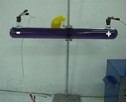


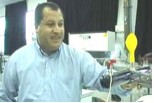
Photo 3: horizontal glass tube as an electrolysis apparatus.
Left photo: 300 ml of sodium sulfate solution in red cabbage extract is electrolysed in a horizontal glass tube (the assistance of a glassblower needed and it is surely not inexpensive apparatus) closed by two rubber stoppers with paper clip electrodes (inexpensive materials) and by an empty balloon (right photo).
Observations:
In a safe area, the balloon will be igniting to corroborate
in a conventional way the presence of hydrogen and oxygen. When
placing the balloon carefully on a fire source, a strong sound
of bomb will be produced (the hydrogen contribution) followed
by a bright flame (the oxygen contribution)
See the explanation for these experiments above.
1.3 Macroscale electrolysis of brine covered by olive oil
In this experiment the Hofmann Apparatus is replaced by an H-shaped container. The electrolyte is brine which is covered by a layer of olive oil.(Photo.4)
Photo 4: Macroscale electrolysis of brine covered by a layer of olive oil
Left: In this experiment, the Hofmann apparatus is replaced by a H-shaped container. The electrolyte is brine which is covered by a layer of olive oil. The electrodes are paper clips.
Observations
Explanations [14, 15]:
Red (at the cathode): 2 H2O (l) + 2 e- --> H2 (g) + 2 OH- (aq)
This is followed by a consecutive reaction between the olive oil at the interface with the products of electrolysis in the cathode tube. This reaction is saponification of the olive oil by the sodium hydroxide formed.
Fatty oil + 3 NaOH (aq) --> Glycerol + 3 R-COO-Na+
(aq)
Ox (at the anode): 2 Cl- (aq) --> Cl2
(g) + 2 e-
The chlorine gas reacts with brine solution producing the HOCl as shown in the following reaction:
Cl2 (g) + H2O --> HOCl (aq) + HCl (aq)
This is followed by a consecutive reaction between the olive
oil at the interface with the products of electrolysis in anode
tube. This reaction involves the addition of HOCl by breaking
the double bonds in the unsaturated olive oil, producing the margarine-like
substance.
These experiments oriented for high-school students. It is suitable
for concluding electrochemistry and organic chemistry.
Microscale chemistry is the reduction of chemicals used to the lowest level at which experiments can be effectively performed. It offers a safer way to perform chemical experiments by using smaller quantities of chemicals. Microscale experiments are conducted without compromising the quality or standard of chemical applications in educational institutions and the experimental industry [7, 8].
Converting to microscale chemistry involves an initial investment of glassware and specialized pipettes. This change is necessary due to the minute amounts of chemicals used in the reactions. Where a 100 ml flask might have worked in conventional chemistry, a 10 or 20 ml flask is more appropriate for microscale chemistry (Photo.5). Specialized pipettes, calibrated to receive only a small amount of a chemical are needed to accurately measure the minute amounts used in this type of chemistry.

Materials and chemicals:
2 Liquemin ampoules 5 ml, wooden test tube stand, bottom of
a disposable styro-foam beaker, two blunted hypodermic needles
as electrodes, 2 insulated copper wires with crocodile clips,
AC/DC adapter 1 - 12 V, plastic pipette, sodium sulfate solution
in red cabbage extract.
Left photo:
1. Pierce the Styrofoam container on the wooden stand from
underneath with the two blunted needles.
2. Transfer 3ml of electrolyte into the container and totally
fill the two ampoules with this electrolyte.
3. Carefully turn the bottles upside down and place them over
the needles.
4. Connect the needles acting as electrodes to the power supply.
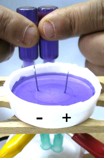 |
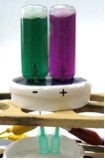 |
|
|
|
Photo 6: Microscale version of the demonstration (Bottle Hoffman); (a) Before electrolysis (purple/purple), (b) after electrolysis (green/red).
Observations Photo 2 - 4: (see: 1.1)
Gas bubbles at both electrodes (double volume at the negative electrode).
Cathode: The colour of the red cabbage juice changes from purple to green.
Anode: The colour of the red cabbage juice changes from purple to red.
Explanation (see: 1.1)
Redox: 6 H2O (l) --> 2 H2 (g) + O2 (g) + 4 OH- (aq) + 4 H+ (aq)
The same as 2.1 but instead of using liquemin ampoules we use plastic pipettes.

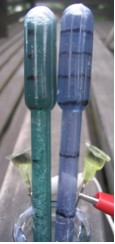
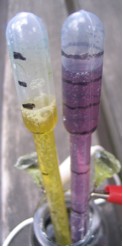
Photo 8: Film canister, needle electrodes, 9 V battarie,
syringe and red cabbage piece (5 cm x 5 cm) in liquemin ampoule
contain hot salty water.
 |
 |
| Photo 9: electrolysis as in 1.1, 1.2, 2.1 and in 2.2 but using 0.1 ml only | Photo 10: neutralisation by mixing the solutions around anode and cathode |
Photo 11: Upper part of the photo; the original colour of the solution. Lower part of the photo; the colour is after mixing product of the electrolysis.
Photo 11: The original colour does not appear.
Explanation: On the anode side, a lower number of water molecules are oxidized as some of the anode material also loses electrons.
In this experiment the 40 ml H-tube container is replaced by
the barrels of two 2 ml syringes placed in a small 30 ml vial.
(The small barrel ends are closed by tiny pieces of tissue paper).
Copper wire is used as the cathode, pencil lead (graphite) as
the anode, replacing the platinum electrodes.
 |
 |
| Photo 12: after 30 minute's electrolysis. | Photo 13: after 12 hour's electrolysis. |
Observations
Left photo (see: 1.3): Foam collects
on top of the cathode syringe.
Right photo: The foam is replaced by solid particles at the cathode
side and the olive oil is transformed into a semi-solid substance
on the anode side
Explanations [14, 15]:
Red (at the cathode): 2 H2O (l) + 2 e- --> H2 (g) + 2 OH- (aq)
As before, saponification of the olive oil by the sodium hydroxide formed at the cathode takes place.
Fatty oil + 3 NaOH (aq) --> Glycerol + 3 R-COO-Na+ (aq and s)
Ox (at the anode): 2Cl- (aq) --> Cl2 (g) + 2 e-
The chlorine gas reacts with brine solution producing the HOCl as shown in the following reaction:
Cl2 (g) + H2O --> HOCl (aq) + HCl (aq)
As before, this is followed by a consecutive reaction between the olive oil at the interface with the products of electrolysis in anode tube. This reaction involves the addition of HOCl by breaking the double bonds in the unsaturated olive oil, producing the margarine-like substance.
The presented simple and familiar apparatus should make these experiments safely available at all levels in chemistry classes.
The simple, familiar apparatus introduced here makes these experiments safely available to all levels of chemistry classes. Students have conducted these experiments in our classes and found them fun and exciting, especially when they visually observe the color changes near the cathode and anode. In addition, the apparatus presented here offers students a versatile tool for the investigation of other examples of electrolysis.
We are grateful to Dr. Peter Schwartz for helpful discussons.